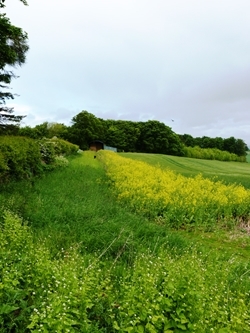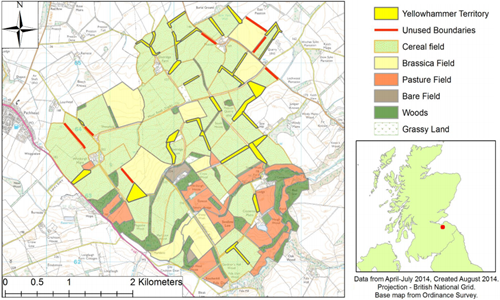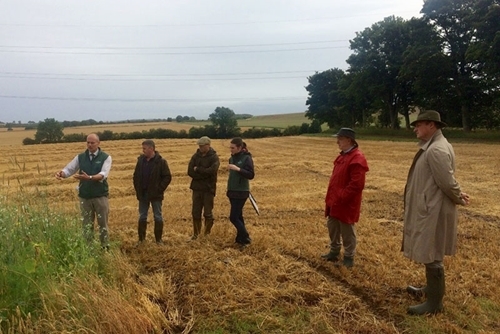 Alastair Salvesen and his team at Whitburgh, Midlothian, have a passion for wild grey partridge. When the farm was bought by Mr Salvesen around ten years ago, it was releasing grey partridge. This was stopped and the focus switched to habitat management, supplementary feeding and the legal control of some common predators. In 2011, the GWCT was lucky enough to get involved and began a programme of monitoring biodiversity to record how various groups responded to the management on site. This also included annual attempts to capture and radio-tag female grey partridge in the early spring, to allow us to better monitor their use of the habitats created for them and their breeding habits.
Alastair Salvesen and his team at Whitburgh, Midlothian, have a passion for wild grey partridge. When the farm was bought by Mr Salvesen around ten years ago, it was releasing grey partridge. This was stopped and the focus switched to habitat management, supplementary feeding and the legal control of some common predators. In 2011, the GWCT was lucky enough to get involved and began a programme of monitoring biodiversity to record how various groups responded to the management on site. This also included annual attempts to capture and radio-tag female grey partridge in the early spring, to allow us to better monitor their use of the habitats created for them and their breeding habits.
Since 2011 we have collected a lot of data from the site with help from the gamekeeper, Graham Rankine, who produces excellent grey partridge counts every spring and autumn, and a number of staff and students who have all contributed. For example, in 2014 Sophie Carr from Newcastle University and Rachel Shepherd from Imperial College London worked on a major census of the songbirds breeding on site to investigate the factors associated with field boundaries that influenced breeding success. Both students worked hard to locate territories for a number of different species and then monitor them frequently to look for signs of chicks – indicating successful breeding. This showed that larger, less gappy, hedges supported more successful territories of a number of species, and that wider herbaceous margins were associated with more successful whitethroat territories.
The distribution of breeding yellowhammers – one of the most abundant species encountered – from 2014 is shown below. You can clearly see how most activity is associated with the boundary habitats.
 © Rachel Shepherd/Imperial College London/GWCT
© Rachel Shepherd/Imperial College London/GWCT
A major part of our ongoing, annual monitoring is the mapping of raptor breeding territories. There are many raptors at Whitburgh, with the most abundant species being the buzzard. Whitburgh offers near-perfect conditions for breeding buzzards as there are lots of small woods (and some larger ones too), surrounded by productive farmland that provides lots of food. Our mapping shows that there are usually around 15 territories on and immediately around the site, with a density of approx. 1.3 territories per square kilometre. This is extremely high: higher than any examples from across Europe that we have been able to find so far in the scientific literature.
How significant is this? Is there any impact of the raptors on the wildlife on site? This question is still unclear, but is something we try to monitor each year. The radio-tracking of our small samples of tagged female grey partridge each spring and summer suggests that the predation rate on the birds is quite high, with raptors being the main predators, taking on average a third of the tagged birds. Predation rates by other animals (e.g. foxes) is usually low – not surprising as Graham works hard to limit vermin numbers during the breeding season – but occasionally can be of the same level. In 2012, when the summer weather was very cold and wet for prolonged periods, raptors took all the 12 tagged female grey partridge, we think because the birds were more vulnerable as they tried to avoid wet vegetation by spending more time in the open (they were certainly more approachable by the field workers).
An important aspect of the work at Whitburgh – even before it became one of the PARTRIDGE demonstration sites – is knowledge transfer: sharing hints and tips on how to manage the countryside for grey partridge and other wildlife with practitioners, and attempting to influence policy makers to improve support mechanisms for farmers. The most recent example of this was a visit by Professor Russell Griggs, the Scottish Government’s Chair of the Greening Review Group (below).
 Professor Russell Griggs’ visit to Whitburgh, September 2017. (From left: Dave Parish, GWCT;
Professor Russell Griggs’ visit to Whitburgh, September 2017. (From left: Dave Parish, GWCT;
Jim Nichol, Whitburgh Farm manager; Graham Rankine, Whitburgh gamekeeper; Fiona Torrance,
GWCT; Prof Griggs; Adam Smith, GWCT).